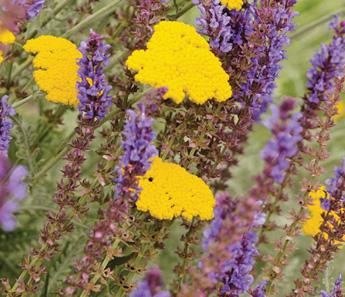Prøve GULL - Gratis
Easy-to-grow achilleas
Amateur Gardening
|August 27, 2022
Ideal for giving the garden a vibrant boost in midsummer, achilleas are a great option to keep the interest going for months, says Graham Rice, as he reveals some of the best

A CHILLEAS are easy to grow and invaluable in the summer border, with a range of flower colours including some that change spectacularly as they fade.
These tough, exceptionally cold-hardy, sun-loving perennials, commonly known as yarrow, first develop a mound of finely dissected, prettily feathered aromatic leaves, in dark green, greygreen or grey.
Achilleas grow best in a sunny site in well-drained fertile soil, and established plants will take drought. Some make tight clumps, some spread more strongly and may be a nuisance, although achilleas are not deep rooted so their spread is easily limited. If not deadheaded, unwanted poor-quality self-sown seedlings will usually appear.
Daisy-like flowers
From late spring to autumn, flat or slightly domed heads of up to 300 small daisy-like flowers are carried on upright stems reaching 16in-5ft (40cm-1.5m) in height. In rich soils the plants may need discreet support from canes and twine.
Flower colour ranges from white through pink and red shades to orange, terracotta and yellow tones, each tiny floret with a white or golden eye. In many varieties the flower colour changes as it matures, and while sometimes this creates an attractively harmonious effect in some varieties the effect can be less appealing. Achilleas are popular with insect pollinators, are good for cutting and they can also be cut for drying.

Good impact plants
Taller achilleas are good impact plants for the back of the border, while smaller varieties are good in front of shrubs and with other perennials in mixed plantings. Deadheading significantly prolongs their flowering season into autumn, especially if the plants are not allowed to dry out.
Denne historien er fra August 27, 2022-utgaven av Amateur Gardening.
Abonner på Magzter GOLD for å få tilgang til tusenvis av kuraterte premiumhistorier og over 9000 magasiner og aviser.
Allerede abonnent? Logg på
FLERE HISTORIER FRA Amateur Gardening

Amateur Gardening
To dig or not to dig?
Should we be carrying out a full dig on plots now? Bob considers the pros and cons of the 'autumn dig' debate
1 mins
October 07, 2023

Amateur Gardening
The box ball blues
As if his beleaguered box hadn't already taken a beating, Toby now has to deal with some hungry box caterpillars
2 mins
October 07, 2023

Amateur Gardening
Save your own seeds
Masterclass on: seed saving
2 mins
October 07, 2023

Amateur Gardening
Strange sightings
Three unusual insects turn up in Val's garden in one day
3 mins
October 07, 2023

Amateur Gardening
A bolt from the blue!
Cornflowers are perfect for garden and vase
1 min
October 07, 2023

Amateur Gardening
Winter moth prevention
Ruth shows you how to avoid maggoty tree fruits
1 mins
October 07, 2023

Amateur Gardening
Create a winter container
There are as many options as in summer
1 mins
October 07, 2023

Amateur Gardening
Lightweight gardening tools
AS well as being good for our mental health, gardening is also great exercise.
2 mins
October 07, 2023

Amateur Gardening
Autumn price round-up
AG finds better bargains in lesser-known brands
3 mins
October 07, 2023

Amateur Gardening
Rudbeckias
Rudbeckias are ideal for sunny summer patios and borders, with some able to survive our coldest winters
4 mins
October 07, 2023
Translate
Change font size
